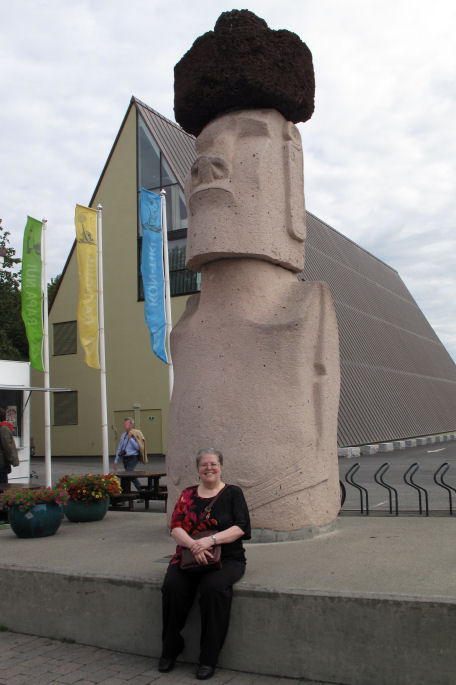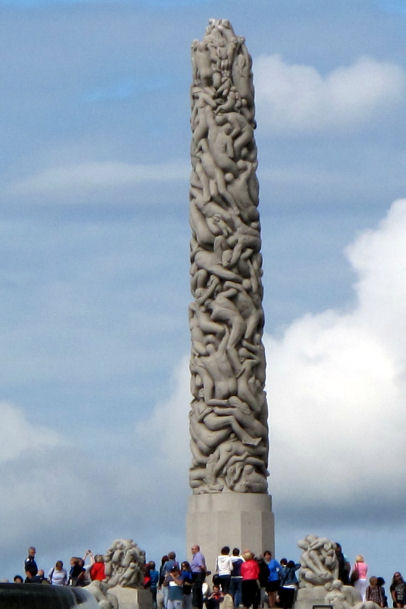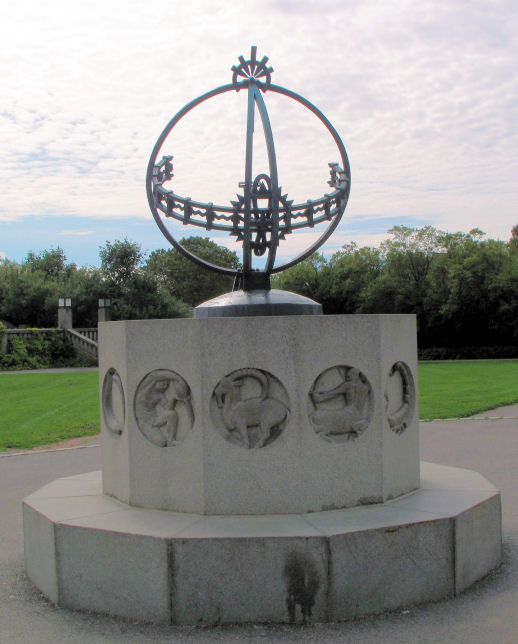I was fascinated by Thor Heyerdahl in my adolesent years but had never really thought what might have happened to his raft...well, it's in Oslo; along with his other boat, the Ra II.
From the internet:
Kon-Tiki was the raft used by Norwegian explorer...Thor Heyerdahl in his 1947 expedition across the Pacific Ocean from South America to the Polynesian islands...He believed that people from South America could have settled Polynesia in pre-Columbian times. Kon-Tiki had a six-man crew...The main body of the float was composed of nine balsa tree trunks up to 45 ft long, 2 ft in diameter, lashed together with 1¼ inch hemp ropes. Cross-pieces of balsa logs 18 ft long and 1 ft in diameter were lashed across the logs at 3 ft intervals to give lateral support. Pine splashboards clad the bow, and lengths of pine 1 inch thick and 2 ft wide were wedged between the balsa logs and used as centreboards. The main mast was made of lengths of mangrove wood lashed together to form an A-frame 29 ft high. Behind the main-mast was a cabin of plaited bamboo 14 ft long and 8 ft wide was built about 4–5 ft high, and roofed with banana leaf thatch. At the stern was a 19 ft long steering oar of mangrove wood, with a blade of fir. The main sail was 15 by 18 ft on a yard of bamboo stems lashed together...The raft was partially decked in split bamboo. The main spars were a laminate of wood and reeds and Heyerdahl tested more than twenty different composites before settling on one that proved an effective compromise between bulk and torsional rigidity. No metal was used in the construction.
For more than that, read his book - it's fascinating...
It's an unassuming building and not especially crowded when we got there...
and I was delighted with a little Easter Island in Norway!
 |
| looks kind of small for six men and a parrot! |
Actually, when you first come into the building you see the Ra II:
again, from the Internet: In 1969 and 1970, Heyerdahl built two boats from papyrus and attempted to cross the Atlantic Ocean from Morocco in Africa. Based on drawings and models from ancient Egypt, the first boat, named Ra (after the Egyptian Sun god), was constructed by boat builders from Lake Chad using papyrus reed obtained from Lake Tana in Ethiopia and launched into the Atlantic Ocean from the coast of Morocco. The Ra crew included Thor Heyerdahl (Norway), Norman Baker (USA), Carlo Mauri (Italy), Yuri Senkevich (USSR), Santiago Genoves (Mexico), Georges Sourial (Egypt) and Abdullah Djibrine (Chad). Only Heyerdahl and Baker had sailing and navigation experiences. After a number of weeks, Ra took on water after its crew made modifications to the vessel that caused it to sag and break apart after sailing more than 4000 miles. The crew was forced to abandon Ra some hundred miles before Caribbean islands and was saved by a yacht. The following year, 1970, another similar vessel, Ra II, was built of totora by Demetrio, Juan and Jose Limachi from Lake Titicaca in Bolivia and likewise set sail across the Atlantic from Morocco, this time with great success. The crew was mostly the same; only Djibrine had been replaced by Kei Ohara from Japan and Madani Ait Ouhanni from Morocco. The boat reached Barbados, thus demonstrating that mariners could have dealt with trans-Atlantic voyages by sailing with the Canary Current.
Both vessels were impressive. I also enjoyed studying some of the other items they included in the exhibit...
 |
| carving of an Egyptian reed boat |
 |
| a fiber representation from Peru of another woven boat |
 |
| a South American basket |
 |
| a Tcherov sculpture of the crew members who sailed with both Ra and Ra II and with the Tigris Expedition Baker - Heyerdahl - Senkevich - Mauri |
 |
| a little more Easter Island... |
 |
| and a Blowfish made into a light! |
Across the street from the Kon-Tiki and the Ra II was the Fram Polar Ship... a ship that was used in expeditions of the Arctic and Antarctic regions by the Norwegian explorers Fridtjof Nansen, Otto Sverdrup, Oscar Wisting, and Roald Amundsen between 1893 and 1912. It was designed and built by the Norwegian shipwright Colin Archer for Fridtjof Nansen's 1893 Arctic expedition in which Fram was supposed to freeze into the Arctic ice sheet and float with it over the North Pole. Fram is said to have sailed farther north (85°57'N) and farther south (78°41'S) than any other wooden ship...(same as previous source)...
Dave actually toured the ship (4 boats was one over my limit for man-toys)...I preferred to sit on a bench and watch the people...
And the weather was nice...
 |
| Dave and the intrepid explorers... |
 |
| at the end of the parking lot, just at the harbor... I really didn't expect to see an inukshuk, but there it was! |













































